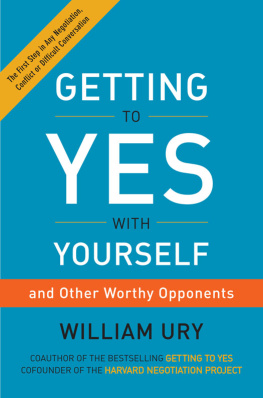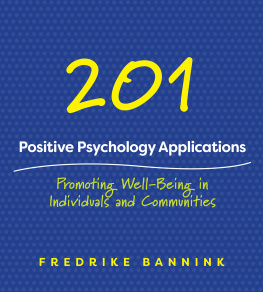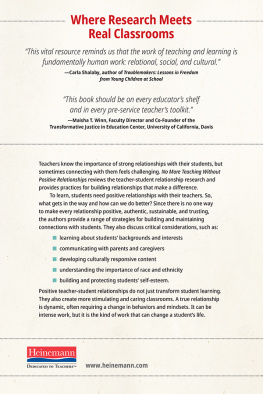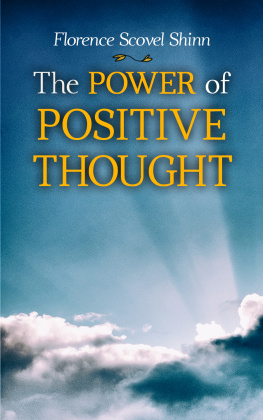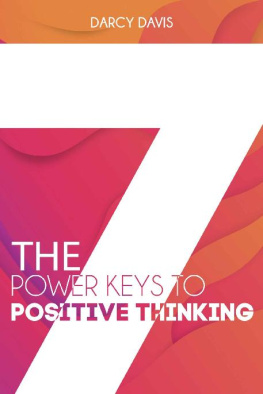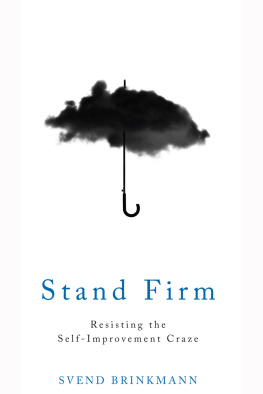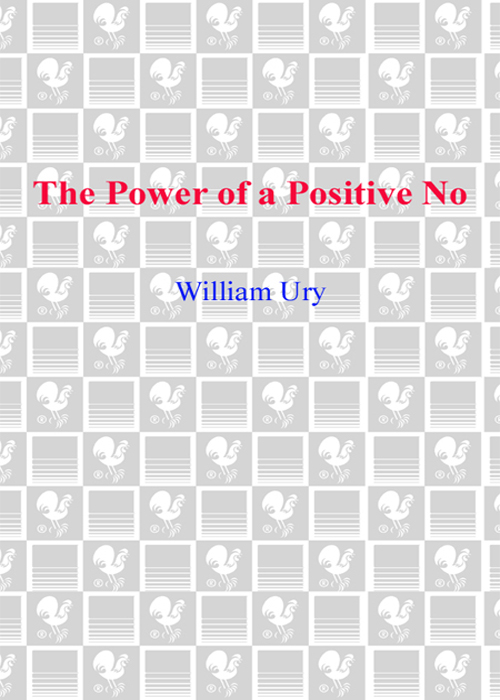
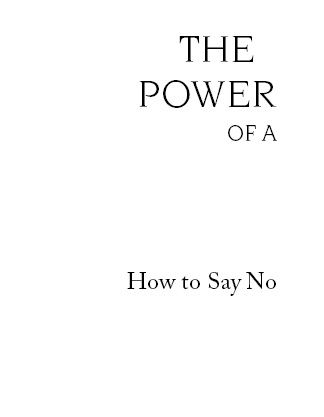
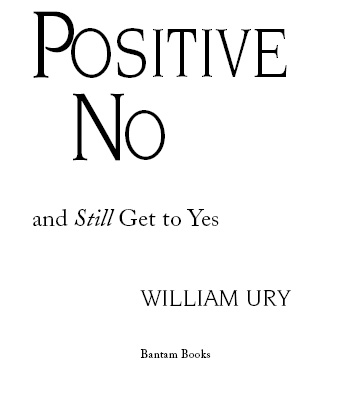
Contents
FOR LIZANNE,
LOVE OF MY LIFE,
WITH ETERNAL GRATITUDE
Acknowledgments
Y ou took five years to write this book? my eight-year-old daughter Gabriela recently asked me in a tone of disbelief.
Yes, I replied.
More than half my life? she asked.
Yes.
What is there to say? All you have to do is say No. Its simple, she said. And you dont have a grabby lead, she added.
Whats a grabby lead?
The first sentence is supposed to grab the readers attention. Yours doesnt, she said.
Oh. It was humbling.
Those who point out our shortcomings are our most benevolent teachersand Gabriela is certainly one of mine. I feel deeply grateful to each of my many benevolent teachers for all the many lessons that have served me so well as this book was written.
Let me begin with my colleagues at Harvards Program on Negotiation, a place that has served as my intellectual home for the past twenty-five years. In particular, I feel very fortunate to have had as my mentors Roger Fisher, Frank Sander, and Howard Raiffa, and as my early colleagues and friends David Lax, Jim Sebenius, and Bruce Patton. I would also like to thank our chairman Robert Mnookin and managing director Susan Hackley for sustaining and strengthening the Program. And I owe a special debt to my colleagues Doug Stone, Daniel Shapiro, and Melissa Manwaring who made invaluable and incisive comments on the manuscript.
No one has worked harder with me on this book than Joshua Weiss, who has been my colleague at Harvard for over a decade. From the books inception, Josh helped with detailed research, and then, as the book took form, with patient readings and useful feedback on at least seven separate drafts. A talented teacher, Josh also helped design the executive seminar at Harvard, which we developed together with the book. My pleasure in working with Josh is exceeded only by my debt to him.
I am also much indebted to Donna Zerner, who early on served as an engaging interlocutor, inspired editor, and encouraging authors friend. At a later stage, Louise Temple and Rosemary Carstens also gave me the benefit of their instructive comments and editing.
I find stories a powerful way of conveying points. I am grateful to Elizabeth Doty, a master at eliciting peoples stories, who gathered numerous examples of saying No from her own interviews and experience, and also offered valuable practical feedback. I would also like to thank Candace Carpenter, Alexandra Moller, and Cate Malek for their careful research and Katia Borg for her artful help with visuals.
My early readers played an essential role in making this book easier for future readers. Mark Walton gently but firmly insisted on simplicity, constantly invoking the magic number three. My sister Elizabeth Ury, with keen ear and discerning eye, brought me back to the original title and the original governing metaphor of the tree. I am also indebted to the helpful feedback I received from my friends John Steiner, Joe Haubenhofer, Jos Salibi Neto, Ira Alterman, Mark Sommer, and Patrick Finerty. The book also benefited from stimulating walks in the mountains with my friends Mark Gerzon, David Friedman, Robert Gass, Tom Daly, Mitch Saunders, Bernie Mayer, and Marshall Rosenbergand in the Brazilian forest with my brother-in-law Ronald Mueller.
For the last two years, Essrea Cherin has served as my executive assistant with high skill and unfailing good spirits, protecting my writing time zealously. I would also like to express my deep gratitude to Kathleen McCarthy and Christine Quistgard, my assistants for many years before. And, for a writing refuge in snow and sun, I would like to thank the good-hearted people of Aspen Winds.
No book succeeds without a good editor. I have been extremely fortunate to work with Beth Rashbaum, whose sensitive editorial touch and gentle urgings to include more of my personal experiences have much improved this book. Let me also record my debt to Barb Burg for her infectious enthusiasm and keen ear for the right framing; and to Irwyn Applebaum and Nita Taublib for believing in the potential of this book.
I also benefited from a savvy and accessible agent, Rafe Sagalyn, who, together with his colleagues Eben Gilfenbaum and Bridget Wagner, diligently and skillfully sought the right home for this book here in the United States and throughout the world. I am grateful to each of them.
On a personal note, I want to acknowledge my profound gratitude to a longtime mentor and family friend, John Kenneth Galbraith, who passed away within the last weeks, for his generous spirit and inspiring example as author and teacher. Nor can I fail to mention a deep debt to my friend and teacher Prem Baba for his precious wisdom in matters of heart and spirit. I am grateful to him beyond measure for many hours of inspiration and insight.
Let me end as I began with my family. I feel extremely lucky to be the father of Christian, Thomas, and Gabriela, who, together with their loyal canine companions Flecky and Miki, have grown up with this book and whose life experiences have informed it. In raising them, my wife Lizanne has succeeded in balancing Yes (love) and No (firmness) with consummate skill. The secret I have learned from her is that true firmness (No) is not the opposite of love (Yes) but actually comes from love and goes toward love. She has been my greatest teacher in the fine art of saying No. I owe more than I can say to her love and devotion, and I dedicate this book to her with all my heart.
I owe one last acknowledgment to my elders: my parents Janice and Melvin, who gave me life and love, my parents-in-law Anneliese (Oma) and Curt (Opa), who have welcomed me with open arms into their family, and my beloved great-aunt Goldyne who, now approaching 102, has long known the secret of saying Nopositively!
William Ury
Boulder, Colorado
June 2006
Authors Preface
GETTING TO NO
I f your baby gets even a cold, she could die, the doctor announced almost offhandedly to my wife and me as we were finishing an appointment. My wife was cradling our infant daughter Gabriela in her arms. Our hearts froze with fear. Gabriela had been born with serious problems in her spinal column, and this doctors appointment was only the beginning of what would prove to be a long journey through the medical systemhundreds of consultations, dozens of treatments, and seven major surgeries in seven years. While our journey is still ongoing, I am happy to write that, despite her physical challenges, Gabriela is healthy and happy. Looking back over the past eight years of negotiating the maze of doctors, nurses, hospitals, and insurance companies, I realize how the process has called on all of the skills I have learned over the years in helping others get to Yes with their negotiation issues. I also realized that, for me personally, the key skill I needed to develop to protect my daughter and our family was saying No.
It began with saying No to the communication style of doctors who, however well intentioned, created unnecessary levels of fear and anxiety in the hearts of parents and patient. It continued with saying No to behaviors such as medical residents and students barging noisily into Gabrielas hospital room in the wee hours of the morning and treating her as if she were an inanimate object. In my work life, it meant saying No to dozens of invitations, requests, and urgent demands to give my time, precious time I needed to spend with family or researching medical issues.


